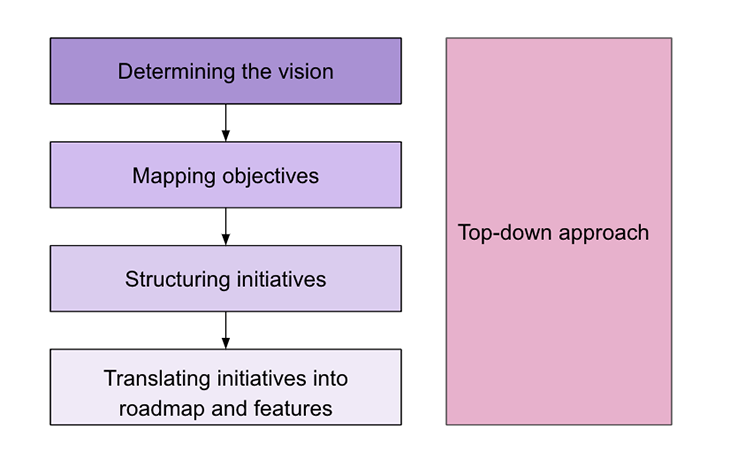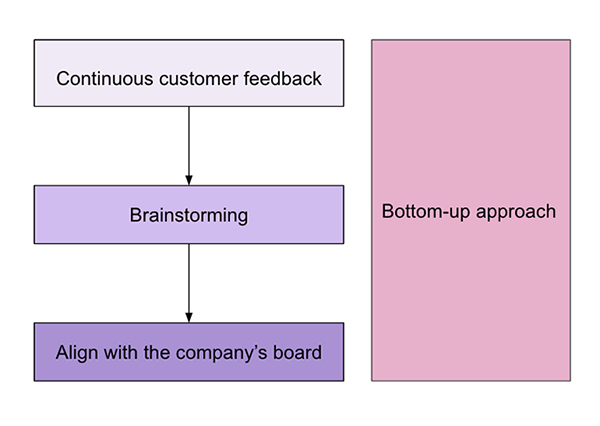Different product teams take different product management approaches. Making critical decisions and overseeing the product development process from conception to market introduction is part of product management.

Throughout the whole process of product management, a lot of problem-solving happens at the organizational and user levels. Thus, product teams rely on two main approaches for processing and arranging information to make it smoother: top-down and bottom-up.
In product management, top-down and bottom-up approaches are the two ways to prioritize features, align these priorities with stakeholders, create a well-rounded product management strategy, and make informed decisions.
The top-down approach begins with the high-level vision and mission of the company. It then works downward to establish a product vision that helps achieve the company’s mission. After that, the top-down approach defines the specific features that will achieve the product vision.
On the other hand, the bottom-up approach begins with individual user problems and needs and works upward. It identifies the products or features that will fulfill those needs and align them with the overall product vision and strategy.
The top-down approach is a strategy of product management where the whole workflow starts from management and goes down toward the roadmap and feature levels. In other words, the priorities are passed to the product managers by the company’s senior executives (or, if fortunate enough, the priorities are created in collaboration with the executives).
This approach is common in two scenes:
Now, let’s discuss the order of the top-down approach in product management.

Oftentimes, the company’s board has a vision that states the (ideal) future of the company and clarifies the business purpose. However, the vision is only the first step in the puzzle — it’s quite wide and hard to execute. So, the board will consider it as a guiding star and move into the next step.
The objectives are the trackers. They tell the company whether they are moving towards their vision or not. Objectives are usually formed from measurable KPIs, product metrics, or OKRs.
In the top-down approach, the company’s board, along with the product leaders (senior product managers, group product managers, etc.) will hold one or more planning meetings (quarterly planning or annual planning) to determine the objectives they assume will move the company towards the vision. They’ll then prioritize, refine, and finalize them, and then communicate them with the entire company.
Product initiatives are a high-level representation of the steps the product team should take to achieve objectives and move closer to the vision. They are the key themes (a mix of features and tasks) the company will invest in delivering.
With the help of the product leaders, the company board will turn the objectives into initiatives that solve multiple problems. The initiative should also be paired with one or more objectives to track progress. Then, the initiatives will be communicated company-wide.
After finalizing the initiatives, the board and the product leaders might want to hold a workshop to brainstorm features that fit into each objective. However, this step is optional and most companies skip it.
After determining the set of features that the company wants to deliver within a certain timeframe, the product leaders will negotiate the product roadmap with the company board, finalize it, and communicate it with the company.
After that, the product leaders will start assigning initiatives and features to different product managers and product teams, and the actual work of designing and building them will start.
On the other hand, the bottom-up approach is where the product team is more involved in determining features and aligning them with strategy. Typically, the whole flow starts with the product team gathering data and customer feedback, as well as doing a lot of market research. Based on the discovery and research work they do, they’ll determine the set of features that customers need and align them strategically with the company’s strategy, vision, and mission.
It’s also known that the bottom-up approach can lead to more user-centered products because it considers user needs when determining priorities. This approach is common in two scenes:

The bottom-up approach is a built-in, company-wide mindset. The company should have already invested in the voice-of-customer (VOC) initiative or built a strategy for continuous customer feedback.
Customer feedback should have a continuous flow to the product team to always keep them informed. Some of the customer feedback channels are:
With continuous flowing feedback, the product team will always have user problems in mind, along with ideas on how to improve the experience and delight customers. The product managers often organize brainstorming sessions, or perhaps design sprints, to achieve a couple of goals:
After coming up with problems and validated solutions, product leaders align with the board on:
Once the alignment is done, the product team(s) can kick-start the execution and build the products their customers need.
In product management, we combine everything. We rarely use one sole framework, method, or approach. We mix and match and tailor to our needs. And that’s the same thing you should do.
Top-down is all about getting the priorities from upper management to build your roadmap, while bottom-up is all about involving the customers more and gathering their feedback to build a backlog and construct a vision from a continuous feedback flow.
Combining both through a voice-of-customer pipeline (aka a feedback pipeline) that connects target users to upper management will come with multiple benefits:
By balancing between both, the product manager can align the high-level goals passed from the executives with the customer needs to prioritize their product backlogs.
Combining both approaches ensures that all company initiatives and decisions related to product management align with the strategy of the company and with the user’s problems and needs.
By shifting focus between both strategies, the product manager will learn how and when to prioritize initiatives that target core customer problems, as well as strategic initiatives passed from the executives.
By switching between both and aligning the stakeholders on the priority, the product manager will improve their agility and have a more holistic view of the problems.
For any product team, the top-down and bottom-up approaches are crucial strategies. The top-down approach provides a high-level vision for the product, while the bottom-up approach ensures that the planned features in the roadmap are prioritized and designed to satisfy the market’s needs and bridge any gaps.
By integrating both strategies, product managers can create an all-around product vision and strategy that balances business objectives with the needs of the users. To build products that meet the target market’s needs and drive business success, product teams need to comprehend the pluses and minuses of both strategies.
Featured image source: IconScout

LogRocket identifies friction points in the user experience so you can make informed decisions about product and design changes that must happen to hit your goals.
With LogRocket, you can understand the scope of the issues affecting your product and prioritize the changes that need to be made. LogRocket simplifies workflows by allowing Engineering, Product, UX, and Design teams to work from the same data as you, eliminating any confusion about what needs to be done.
Get your teams on the same page — try LogRocket today.

A practical framework for PMs to use AI in ideation without sacrificing judgment, strategy, or decision quality.

A practical five minute revenue estimation method to help product managers compare ideas, drop low impact features, and prioritize smarter.

A practical guide for PMs who want to stop being bottlenecks, delegate smarter, and lead teams effectively with a clear ownership framework.

Stop letting unreliable data block features. Treat data as inventory to track quality, ownership, and ship with confidence.